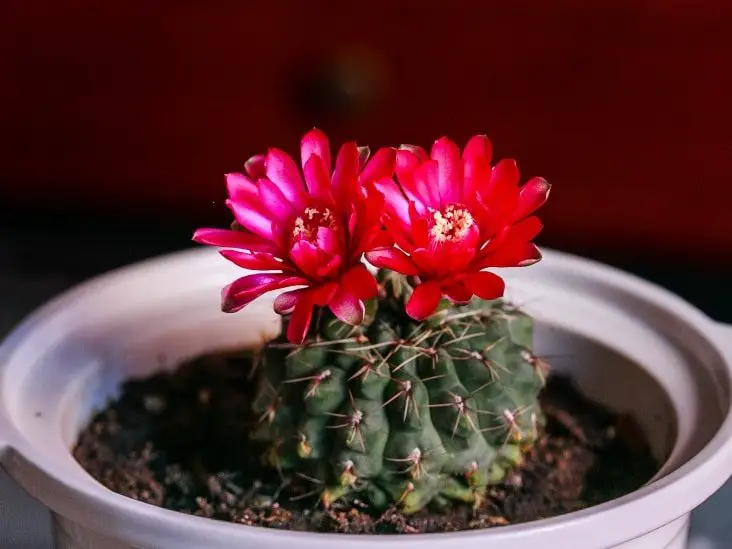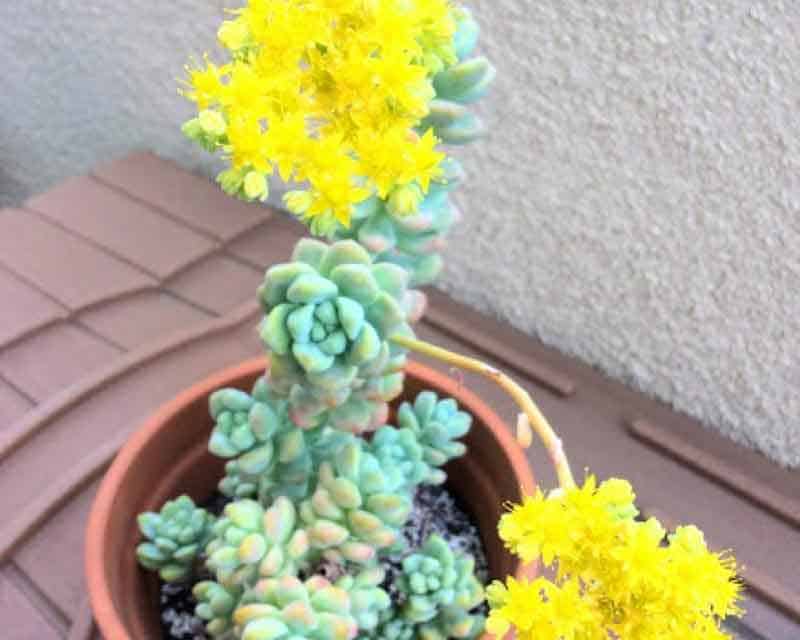Do Cacti Plants Die After Flowering

After a cactus flowers, it may seem like the plant is dying. The flower wilts and the stem that held the flower begins to shrivel. However, this is not necessarily a sign that the plant is dying.
In fact, flowering is often a sign of good health in cacti. Once a cactus has flowered, it will typically produce fruit. This fruit is an important part of the cactus’ life cycle and helps to spread its seeds.
While it may look like your cactus is dying after it flowers, in reality, it is probably just getting started on its next phase of life.
After a Cactus Flowers. What do you do with the wilted cactus blooms? | #Cactus Care
When it comes to cacti, there is a common misconception that they die after flowering. This simply is not true! While cacti do go through a natural process of dying back after blooming, this does not mean that the plant itself dies.
The reason for this phenomenon is because once a cactus blooms, it has expended all of its energy and nutrients into producing flowers. Therefore, the plant will enter a state of dormancy in order to conserve energy and regenerate itself. Once the regeneration process is complete, the cactus will start to grow again and eventually bloom once more.
What to Do When Cactus Flowers Die
If your cactus flowers die, don’t despair! There are a few things you can do to revive them. First, check the soil moisture and make sure the plant is getting enough water.
Second, make sure the plant is in a sunny spot – cacti need plenty of sunlight to bloom. Finally, give the plant some time – sometimes it takes a while for cactus flowers to re-bloom. With a little patience, you’ll soon have beautiful blooms on your cactus once again!
Monocarpic Cactus
Monocarpic cactus are cacti that only bloom once before dying. The most famous monocarpic cactus is the saguaro, which can live for up to 200 years without blooming. When a saguaro does finally bloom, it produces a spectacular show of flowers that attract bees and other pollinators from miles around.
After blooming, the saguaro dies, leaving behind a hollow shell that provides homes for small animals.
Other monocarpic cacti include the hedgehog cactus and the fishhook barrel cactus. These cacti typically live for 10-20 years before blooming and then dying.
Like the saguaro, they produce large quantities of flowers that attract pollinators from far and wide.
Monocarpic cacti are an important part of desert ecosystems. They provide food and shelter for a variety of animals, and their death creates openings in the landscape that allow other plants to take root.
These openings also help control erosion bycatchment basins during rainstorms.
While monocarpic cacti may seem like a sad story (they do die after all), they play an essential role in deserts around the world.
Why Do Cactus Flowers Only Last a Day
If you’ve ever wondered why cactus flowers only last a day, you’re not alone. This is a question that many people have, and it’s one that has a bit of a complicated answer. To understand why cactus flowers only last a day, we need to first understand a little bit about how cacti reproduce.
Cacti reproduce by flowering. When the conditions are right (usually after a period of drought), the cactus will produce a flower. The flower blooms for just one day before it withers and dies.
During that time, however, the flower is very attractive to pollinators like bees. The bee collects pollen from the stamen of the flower and then transfers it to the pistil of another flower (of the same species). This process fertilizes the ovules in the pistil and results in seed production.
So why do cactus flowers only last for one day? Well, it’s actually an evolutionary adaptation that helps ensure successful reproduction. By blooming for just one day, the flower minimizes its chances of being eaten by predators or damaged by weather conditions.
Additionally, this short bloom time means that bees are more likely to visit multiple flowers within a single species (thus increasing cross-pollination). Ultimately, this strategy leads to healthier offspring with greater genetic diversity – both traits that help ensure long-term survival of the species.
Cactus Death Bloom
The Cactus Death Bloom is a rare event that occurs when a cactus dies. The bloom is often very colorful and can last for several weeks. This event is most often seen in the desert regions of the United States, but has also been reported in other parts of the world.
Cacti are succulents, meaning they store water in their leaves and stems. When a cactus dies, it stops taking in water and the stored water begins to evaporate. This causes the cactus to shrink and the stem to collapse.
As the water evaporates, it carries with it any pigment that was present in the plant tissue. This can result in a very colorful bloom as the pigments are concentrated in a small area.
The Cactus Death Bloom is not just visually stunning, but it also serves an important purpose.
The bright colors attract pollinators like bees and butterflies which help to spread the pollen of other cacti nearby. This helps to ensure that new cacti will be able to grow even after one dies.
If you are lucky enough to see a Cactus Death Bloom, be sure to take some time to appreciate its beauty!
Should I Remove Dead Flowers from Cactus
If you have a cactus that is blooming, you may be wondering if you should remove the dead flowers. The answer depends on the type of cactus and your personal preference.
Some cacti, such as the Easter lily cactus (Rhipsalis spp.), will continue to bloom even if the flowers are removed.
Others, such as the queen of the night (Epiphyllum oxypetalum), will stop blooming if the flowers are removed. If you’re not sure which type of cactus you have, it’s best to err on the side of leaving the dead flowers in place.
Removing dead flowers can also help to promote new growth.
If your cactus is starting to look leggy or sparse, removing spent blossoms can encourage it to produce more shoots and leaves.
Ultimately, whether or not you remove dead flowers from your cactus is up to you. There are benefits to both leaving them in place and taking them off.
Experiment and see what works best for your plant!

Credit: succulentplantcare.com
What to Do With Cactus After It Blooms?
If you have a cactus that has bloomed, you may be wondering what to do with it next. Here are some tips on how to care for your cactus after it blooms:
1. Allow the flowers to wilt and die before removing them from the plant.
This will prevent any damage to the cactus itself.
2. Once the flowers are removed, cut back any dead or dying leaves or stems.
3. If your cactus is pot-bound, you may want to repot it into a larger container at this time.
Be sure to use a well-draining potting mix and provide adequate drainage holes.
4. After repotting, water your cactus sparingly until it becomes established in its new home. Then, water as needed based on the plant’s needs (usually every 1-2 weeks).
Which Cactus Dies After Blooming?
There are many cacti that bloom only once and then die, but there are also some that will bloom multiple times before they reach the end of their lifespan. One example of a cactus that dies after blooming is the Queen of the Night (Epiphyllum oxypetalum). This cactus is native to Mexico and can grow up to 3 feet tall.
The flowers on this plant are large and fragrant, but they only bloom at night. Once the flowers fade, the plant will die. Other examples of cacti that die after blooming include members of the genus Cereus and some species of Euphorbia.
Should I Remove Flower from Cactus?
If you want your cactus to flower, then you shouldn’t remove the flower. The flowers on a cactus are typically relatively small and insignificant, so if you’re not worried about aesthetics, then there’s no need to remove them. However, if the flowers are getting in the way or if they’re detracting from the overall appearance of your cactus, then go ahead and snip them off.
Will the Cactus Plants in the List Die After Flowering?
Will the tall cactus varieties in the list die after flowering? It is a common misconception that cactus plants will wither away after blooming. However, most tall cactus varieties are built to withstand this process. While individual cacti may vary, in general, they will continue to grow and thrive even after flowering, adding beauty to your space for years to come.
What Happens When Cacti Bloom?
When a cactus blooms, it means that the plant is healthy and happy. The flowers of a cactus are beautiful and unique, and they only bloom for a short time. After the flowers die, the cactus will produce fruit.
Conclusion
According to the gardener’s blog post, cacti plants generally die after they flower. The plant produces a large amount of energy to create the flowers, and once the flowers bloom and die, the plant has nothing left to give. The gardener recommends keeping an eye on cacti plants that are in full bloom, and if they start to wilt or turn brown, it’s time to say goodbye.